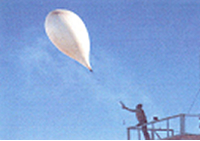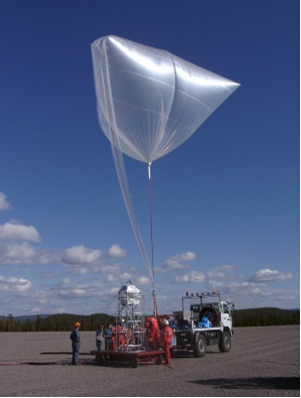Weather balloons
Weather Balloons are another very common cause for UAP sightings. Several types are released from centres all over the world. Some are small and just test wind direction. Others have complex instrument packages on them, and drift high in the atmosphere performing experiments. It is the latter that appear to generate the majority of spurious UAP reports.
Such high-flying balloons are visible in daylight due to their reflective surfaces. In sunlight they will look silvery. Against a cloudy background they may look grey or dark. Naturally they drift with the wind (although wind direction at height may not be the same as on the ground). Usually they are clearly identifiable by their small round shape, but if seen closer to the ground they may be triangular or conical. Their motions tend to be exceedingly slow. Problems can arise when a balloon becomes caught in a thermal updraft. It may seem to change direction suddenly and dramatically. Very few balloons carry navigation lights, but some do if they are likely to cross airways at night.
To identify a balloon it is necessary to find out whether one was launched at a centre downwind of the sighting location, and of course to have full records of the wind velocity and direction at various heights. The centre that launched the balloon can usually help confirm whether or not one was likely to be visible over a certain position at a certain time; a radiosonde being capable of travelling up to 125 miles (200 km) from its launch-site. It can be fun plotting the course and times on a map and estimating time of arrival at the sighting location.
These balloons are initially around of 6-8 feet (1.80 – 2.40 metres) in diameter, expanding to 30-35 feet (9.00-10.5 metres) at `burst’ height. ‘Burst’ height is the height at which expansion due to decreasing air pressure causes the balloon to burst. This is normally between 60,000 and 115,000 feet (18,300 – 35,000 metres). The rate of ascent of these balloons is approximately 1,200 feet (366 metres) a minute, giving a normal lifetime for each balloon of around 1-2 hours.
Small disc-shaped helium balloons, up to one foot (30 cm) in diameter and coloured silver on one half and dark on the other have instigated a significant quantity of “UAP” reports since the early 1980’s. These tend to be seen at fairly low elevation drifting with the prevailing ground level wind. If perceived as a largish object some distance from the observer they will be reported as moving relatively fast. As these are often sold at fetes it may be useful for Investigators to check whether such an event occurred downwind of the observer.
Telltale signs: Slow drifting motion with the wind. In regards to high attitude research weather balloons a long duration of observation and multiple witnesses (possibly over an extensive area over a period of many hours).
Resources:
NASA Balloon Programme Office:
http://sites.wff.nasa.gov/code820/

